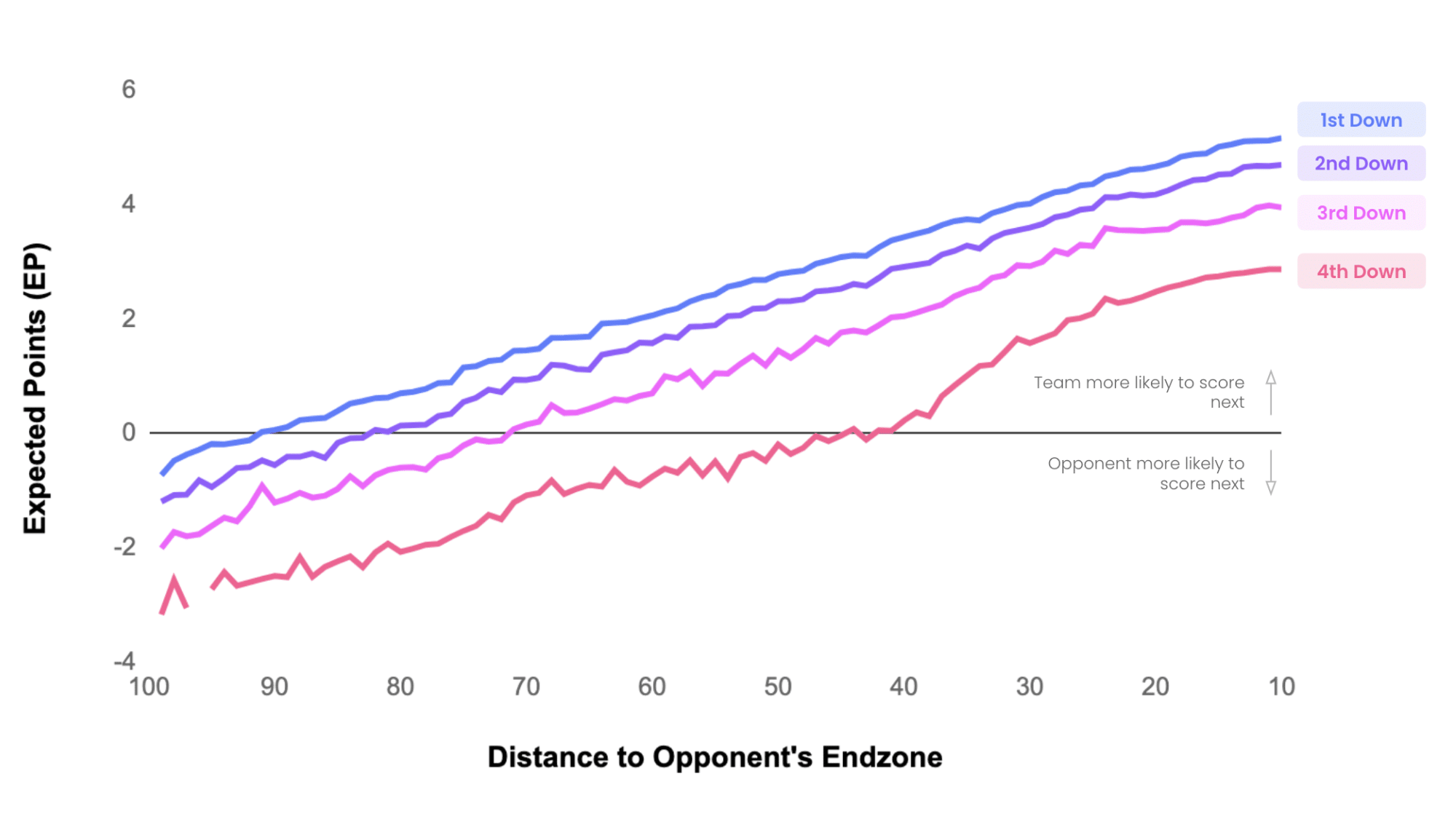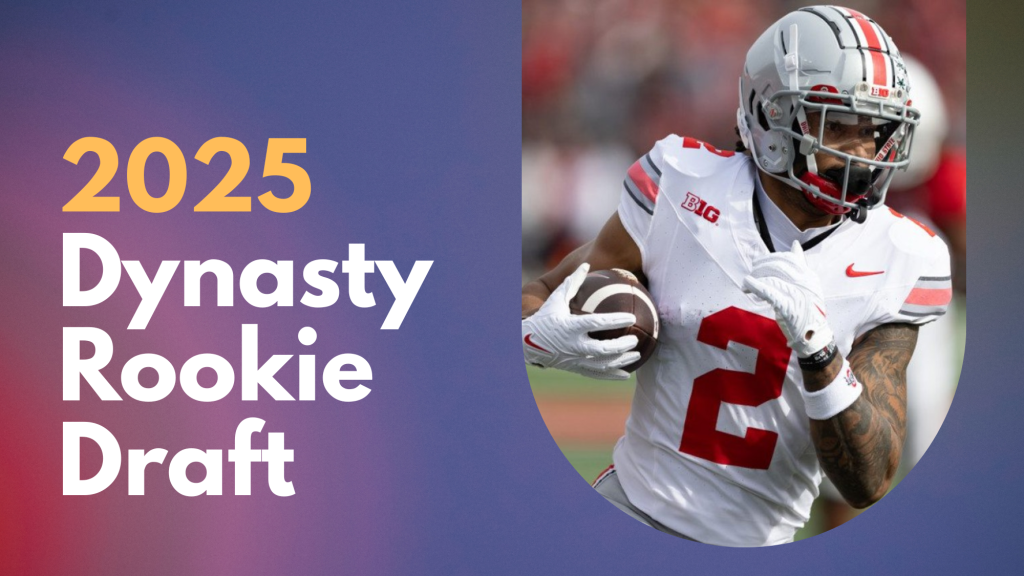Have you ever noticed how some short plays in football feel like game-changers, while longer ones don’t always seem that important?
That’s because not all plays carry the same weight, and there’s actually a way to measure that.
Coaches and analysts use a stat that helps break down how much each play truly matters in the context of the game.
It goes beyond yards and touchdowns and looks at real impact.
Let’s take a closer look.
What Does EPA Mean in Football?
EPA stands for Expected Points Added, and if you don’t know what exactly it is, don’t worry. You’re not alone.
This football statistic sounds way more complicated than it actually is, but once you understand it, you will start seeing the game in a completely different way.
Think of EPA as a way to measure how much value each play adds to a team’s chances of scoring.
Instead of just looking at whether a play gained 5 yards or 10 yards, EPA asks the more important question: “How much did this play actually help the team score points?“
Why Does This Matter?
Because not all yards are created equal.
Gaining 5 yards on 3rd and 4 is way more valuable than gaining 5 yards on 1st and 10. EPA captures this difference, making it one of the most important metrics in modern football analytics.
How is EPA Calculated?

Before every play, statisticians assign an “expected points” value based on the situation.
This considers things like what down it is, how many yards to go, where the ball is on the field, and how much time is left.
The EPA formula is actually pretty simple:
EPA = (Expected Points After Play) – (Expected Points Before Play)
Let’s break this down with an example:
- Your team has the ball on their own 20-yard line, 1st and 10
- Based on historical data, teams in this situation score about 1.2 points on average
- You throw a 15-yard pass to the 35-yard line
- Now you’re in a situation where teams historically score about 1.8 points
- Your EPA for that play = 1.8 – 1.2 = +0.6
When you calculate EPA this way, you can see the expected points (EP) value for any situation in the NFL.
Why is the EPA Useful in Football Analytics?
The EPA solves a significant problem with traditional football statistics; they don’t tell the whole story.
A quarterback might throw for 300 yards, but if most of those yards came when his team was already losing by 20 points, how valuable were they really? EPA explained in this context shows the true impact.
Here’s why EPA is so much better:
| Benefit | Description |
|---|---|
| Measures Real Impact | Values play based on outcome, e.g., a 3-yard gain on 4th & 2 can be more valuable than 20 yards on 1st & 10. |
| Context-Aware | Takes field position, down, and distance into account; the same play can have different EPA values. |
| Cross-Comparison Tool | Allows fair comparisons across teams, systems, and eras by adjusting for the situation. |
| Informs Better Decisions | Helps coaches make smarter choices based on data, rather than relying on gut instinct or tradition. |
EPA analysis has become essential for NFL teams looking to gain a competitive edge through advanced analytics.
Some Real-Life Examples of EPA Application
Here are some real-life applications of EPA:
1. Offensive Play Calling: Run vs Pass
Let’s say you want to know whether your team should run or pass more often. Looking at yards per play might be misleading, but EPA tells you all.
Maybe your team averages 4.2 yards per carry and 6.8 yards per pass attempt. Basic stats would say “pass more!“
But what if your running plays have a higher EPA? That might mean your runs are coming in better situations or setting up more scoring opportunities. The offense EPA can reveal patterns that traditional stats miss.
2. Player Evaluation: Ranking Quarterbacks
Traditional stats might rank quarterbacks by passing yards or touchdowns. But the EPA gives you a much clearer picture of who is actually helping their team score.
A quarterback who throws a lot of short passes might have a high completion percentage but a low EPA if those passes aren’t moving the chains or putting the team in scoring position.
Meanwhile, a quarterback with fewer yards but higher EPA is probably making more valuable plays. Many NFL player rankings now incorporate EPA alongside metrics like CPOE and success rate.
Understanding EPA Expected Points Added in the NFL
EPA expected points metrics have revolutionized how we evaluate team performance in the NFL. When looking at total EPA over a season, you can quickly identify which teams are truly elite on offense and defense. Sites like PFF and ESPN now feature EPA prominently in their analysis, making it easier for fans to access these insights.
The beauty of EPA is that it works for both fantasy football analysis and real NFL team evaluation. Whether you’re trying to understand why your favorite team struggles in the red zone or looking for undervalued players for your fantasy roster, EPA provides the context that traditional stats often miss.
How Can You Use EPA When Watching Football?
Well, you don’t need to calculate the EPA yourself. There are tons of resources that make this data easy to access and understand.
During Games:
- Many broadcasts now show EPA and win probability graphics.
- You can follow along with apps that show real-time EPA for each play.
- Look for situations where the EPA suggests a different strategy than what the team is doing.
After Games:
- Check out the EPA summaries to see which plays and players had the biggest impact.
- Compare team EPA on offense and defense to get a better sense of overall performance.
- Use the EPA to evaluate coaching decisions, especially on fourth downs.
Public Resources:
- Websites like Pro Football Reference now include EPA data.
- Twitter accounts like @benbbaldwin regularly share EPA insights.
- NFL’s Next Gen Stats includes EPA in their analysis.
- EPA ESPN coverage has expanded significantly in recent years.
End Note
EPA is a great tool for seeing football more smartly.
It helps you look past big yardage plays and focus on which ones really helped the team score. It’s not perfect, and you don’t need to forget everything you already know.
But once you start using EPA, games become more fun to watch.
Next time you are watching a big play, you will start noticing things most fans miss. The success rate of different play types, the true value of field position, and which players consistently add points to their team’s expected total all become clearer with EPA.




















